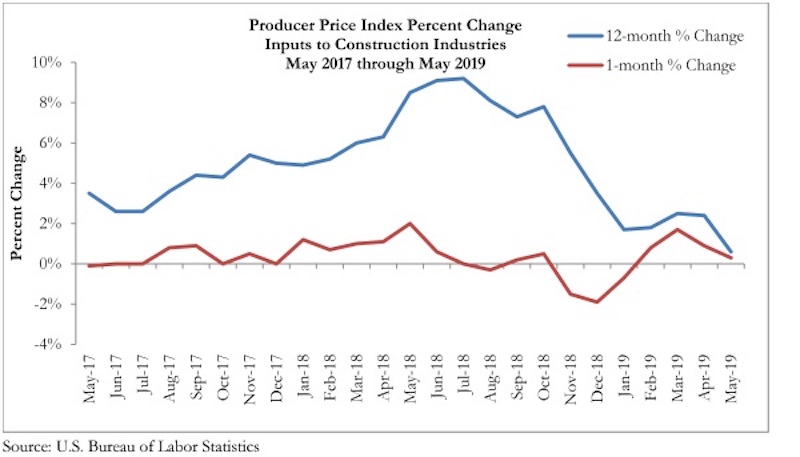Construction input prices rose slightly by 0.3% in May on a monthly basis and are up 0.6% over the last 12 months, according to an Associated Builders and Contractors analysis of U.S. Bureau of Labor Statistics data released today. Nonresidential input prices were also up 0.3% compared to the previous month and are 1.1% higher than they were a year ago.
Among the 11 subcategories, six saw prices fall last month, with the largest decreases in natural gas (-15.2%), unprocessed energy materials (-8.2%) and crude petroleum (-6.2%). Of the remaining five subcategories, only two experienced price increases greater than 1%: nonferrous wire and cable (+1.2%) and prepared asphalt, tar roofing and siding products (+1.1%), which also had the largest year-over-year price increase at 6.3%.
“Based on a variety of factors, materials prices should be escalating in the United States, yet nonresidential construction materials prices remain relatively stable,” said ABC Chief Economist Anirban Basu. “First, demand for materials remains high in the context of ongoing growth in nonresidential construction spending. This is especially true for a number of construction material intensive segments like highway and street. Indeed, prepared asphalt is the only category of construction materials that this report monitors that experienced a price increase exceeding 6% over the past year.
“Second, there is the issue of tariffs, including those that have impacted steel and aluminum prices in recent months,” said Basu. “Despite those surcharges on imported goods, no related categories are associated with significant inflationary pressure, though the price of fabricated steel products is up by a somewhat-above-average 2.8% over the past year. Third, there have been active attempts by certain groups of suppliers, including OPEC members, to truncate supply in an effort to raise prices. In large measure, those efforts have failed, with a host of commodity prices, including oil prices, declining recently.
“There are many factors that have helped to limit materials price increases, including a weakening global economy and the emergence of goods-producing nations like Vietnam and Indonesia,” said Basu. "A strong U.S. dollar has also helped to limit the commodity price increases encountered by America’s construction firms.
“For contractors, this comes as good news,” said Basu. “While U.S. construction firms will continue to wrestle with rising compensation costs, materials prices are likely to remain well behaved over the near term. There is little evidence that the global economy is reaccelerating. Moreover, the Trump administration recently removed tariffs on steel and aluminum with respect to Canada and Mexico. Finally, while public construction spending growth has been robust of late, there is some evidence that spending growth has become less intense in a number of private construction segments, which would have the effect of limiting demand for certain materials, all things being equal.”
Related Stories
Multifamily Housing | Aug 12, 2016
Apartment completions in largest metros on pace to increase by 50% in 2016
Texas is leading this multifamily construction boom, according to latest RENTCafé estimates.
Market Data | Jul 29, 2016
ABC: Output expands, but nonresidential fixed investment falters
Nonresidential fixed investment fell for a third consecutive quarter, as indicated by Bureau of Economic Analysis data.
Industry Research | Jul 26, 2016
AIA consensus forecast sees construction spending on rise through next year
But several factors could make the industry downshift.
Architects | Jul 20, 2016
AIA: Architecture Billings Index remains on solid footing
The June ABI score was down from May, but the figure was positive for the fifth consecutive month.
Market Data | Jul 7, 2016
Airbnb alleged to worsen housing crunch in New York City
Allegedly removing thousands of housing units from market, driving up rents.
Market Data | Jul 6, 2016
Construction spending falls 0.8% from April to May
The private and public sectors have a combined estimated seasonally adjusted annual rate of $1.14 trillion.
Market Data | Jul 6, 2016
A thriving economy and influx of businesses spur construction in downtown Seattle
Development investment is twice what it was five years ago.
Multifamily Housing | Jul 5, 2016
Apartments continue to shrink, rents continue to rise
Latest survey by RENTCafé tracks size changes in 95 metros.
Multifamily Housing | Jun 22, 2016
Can multifamily construction keep up with projected demand?
The Joint Center for Housing Studies’ latest disection of America’s housing market finds moderate- and low-priced rentals in short supply.
Contractors | Jun 21, 2016
Bigness counts when it comes to construction backlogs
Large companies that can attract talent are better able to commit to more work, according to a national trade group for builders and contractors.



















